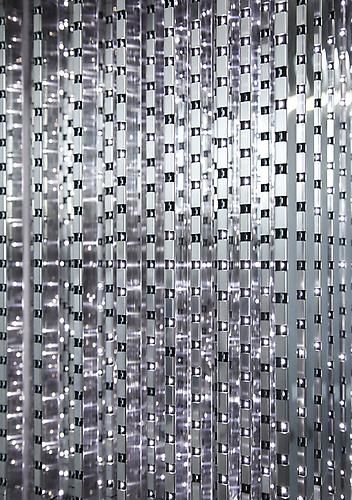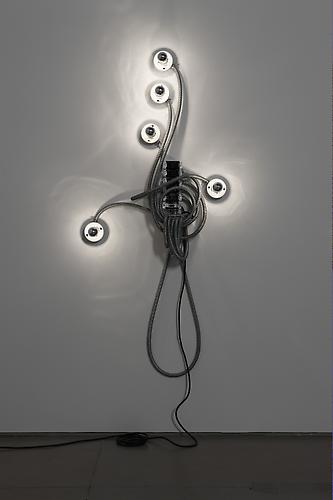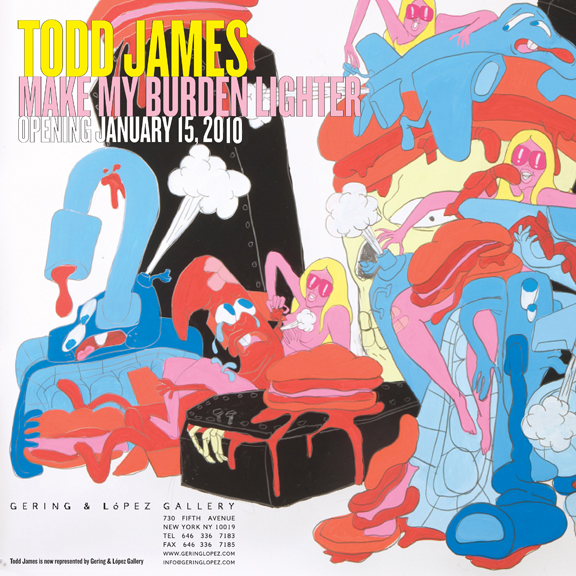
Tag: GERING & LóPEZ GALLERY
Leo Villareal – Volume
JOHN F. SIMON
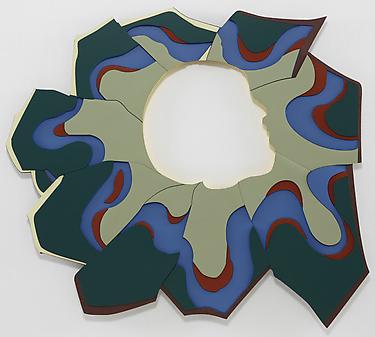
Continuing to experiment with software and robotic fabrication, Simon adds another dimension to the translation of his drawings from the digital to the physical. The new bas-reliefs made of wood and formica in Simon’s current exhibition elaborate on his long term fascination with automated mark making.
In his first exhibition with Sandra Gering Gallery in 1998, Simon showed pen-plotted ink drawings on paper generated from software tools he wrote called “Mobility Agents.” This new body of work relies on similar computer control to realize larger scale pieces. By layering line, color, and material, Simon invites you to “consider how things are defined by what surrounds them.” The innerhole calls attention to the negative space at the center.
The conceptual aspect of the work reflects Simon’s deepening dedication to drawing and understanding the sources of his own creativity. For the past eleven years, Simon has committed himself to a daily practice of drawing through which he observes his own intuitive markings, posting them on iclock.com. He then seeks to codify these improvisations, interpreting the drawings through different media including software, paper and wood. In setting out to automate improvisation through self-observation, he is guided by the practices of artists like André Breton, Jean Arp and John Cage, whose work relies on impulse and chance.
innerhole is John F. Simon, Jr.’s eighth solo exhibition in New York. Born in Louisiana in 1963, he currently lives and works in Orange County, New York. He has an MFA in Computer Art from the School of Visual Arts and additional degrees from Brown University in Providence, RI, and Washington University in St. Louis, MO.
Two works from the innerhole series will be included in the upcoming group show curated by Hubert Neumann, The Incomplete, at Galerie Jean-Luc & Takako Richard, Paris, France. His work is found in prominent museum collections such as the Museum of Modern Art, New York, the Solomon R. Guggenheim Museum, New York, the Whitney Museum of American Art, New York, and the Los Angeles County Museum of Art, California.
Michael Bevilacqua
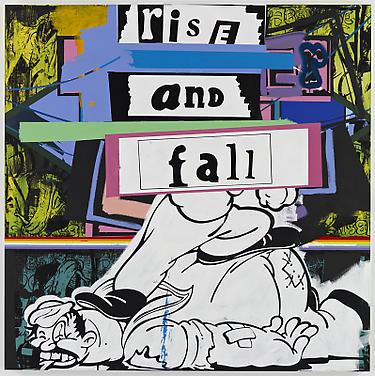
GERING & LóPEZ GALLERY is pleased to present Placebo Effect, an exhibition of new paintings on linen by New York based artist Michael Bevilacqua. This will be Bevilacqua’s second solo exhibit with the gallery. This exhibition, radically different from his last at the gallery, is much more minimal, starkly showcasing his technical and conceptual skill as a painter.
Contrary to popular trends in art and art theory, Bevilacqua is not afraid to admit that he is an autobiographical artist. Each painting is a series of diary entries, painted and repainted as he explores and reflects on the world around him. Each work starts with a song, the soundtrack of Bevilacqua’s life at that given moment of creative production. These works display clear references to the bands the Ramones, Gorillaz, and Placebo, through lyrical text often scrawled graffiti-style across the canvas or in cutout block lettering. The textual component interacts with abstracted cartoon characters and objects, forcing the viewer to oscillate between background and foreground. Through this visual language, Bevilacqua weaves his personal narratives, stories and emotions that under- and overlap each other in the layers of screenprinting, stencils, and free hand acrylic brushstrokes.
Bevilacqua further deviates from the contemporary status quo of a Neo-Modernist approach to the picture plane with his vibrant use of color, which simultaneously intertwines multiple painting techniques across the canvas, stretching our conventional notion of collage. He creates a myriad of surfaces all functioning within the confines of a single plane, similar to the way we open endless windows on our computer screens. These multiple layers of color, technique, and references provide the eye with many opportunities to wander, but there is no resolution.
The complexity and depth of this work relates directly to the artist as a person. He is exploring issues of self, family, art, and the co-existing roles he must play as well as the power the practice of painting has over these internal struggles. This leads to his enigmatic title, Placebo Effect. A clear reference to the music group, the title can have multiple secondary metaphorical interpretations. Bevilacqua could be feeding himself this sugar pill, pouring his life onto an inanimate piece of stretched linen as a form of therapeutic relief, or he could be serving it to the viewer, the voyeur. He has lived this, and your viewing experience is merely a “placebo effect” of Michael Bevilacqua’s life.
Michael Bevilacqua was born in Carmel, California in 1966. He attended Long Beach State University and Santa Barbara City College, later continuing his studies at the Cambridge College of Art and Technology in Great Britain. Bevilacqua has exhibited internationally including solo shows in Beijing, Copenhagen, Milan, Tokyo, Madrid, Barcelona, and New York. He has also exhibited in group shows at Palais de Tokyo, Paris, France; Deste Foundation, Athens, Greece; The Phoenix Art Museum, Phoenix, AZ; and The Aldrich Museum of Contemporary Art, Ridgefield, CT. His work is in numerous public collections including The Mitsuni Collection, Tokyo, Japan; San Francisco Museum of Modern Art, San Francisco, CA; Deste Foundation, Athens, Greece; Astrup Fearnley Museum, Oslo, Norway; The Whitney Museum of American Art, New York; and The Dallas Museum of Art, Dallas, TX.
WILLIAM ANASTASI
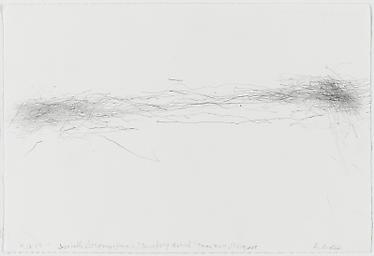
GERING & LóPEZ GALLERY is pleased to present WILLIAM ANASTASI: Drawings. This will be Anastasi’s first exhibition with the gallery, and his fifth solo exhibition with Sandra Gering.
In a recent statement for the Foundation for Contemporary Arts in honor of his receipt of the 2010 John Cage Award, Anastasi remarked that one of his earliest memories was his Italian immigrant mother calmly telling him that “But of course the best thing anyone could be in this world is an artist.” Although his canonical works have influenced generations of artists and are in the permanent collections of the most prestigious institutions in the world, Anastasi closed his statement to the Foundation for Contemporary Arts with a quotation from Kant’s Critique of Pure Reason: “Nearly through the whole of my work I have felt doubtful what to do.” Well-known to art world insiders as the perennial conceptualist, there is a strikingly human vulnerability in the artist’s oeuvre and method.
Anastasi’s practice is interdisciplinary, informed by physics, music, and social thought. Like his close friend John Cage, Anastasi is fascinated by the element of chance in creation. The strongest intentionality in his work comes from his attempts to block out his conscious sensory responses to his surroundings. He has famously blindfolded himself and drawn to the background ‘noise’ of classical music, making every effort to prevent the sound from influencing his movements. He wears noise-canceling headphones on the subway in order to create his own sensory deprivation experience while he produces his Subway Drawings. By attempting to exclude his senses from the artistic process, Anastasi acts as a passive conduit through which Art passes, a perfect example of the ideal Heideggerian artist. Anastasi finds chance much more intriguing than volition, and has always thought the aesthetic result of his work fared better when he did not look at the drawing, or when he let a pair of dice decide where the markings should go.
The drawings in this exhibition showcase the conceptual and tangible possibilities randomness brings forth. Works include examples from major series that Anastasi began in the 1960s, as well as new works from the present day such as pocket drawings, subway drawings, constellations, theatre drawings, bursts, and drop drawings. This complex figure, perhaps plagued by self-doubt and on a ceaseless quest for self-discovery, has secured his position as a seminal Artist, and continues to innovate today.
William Anastasi was born in Philadelphia, PA in 1933. The recipient of the 2010 John Cage Award, Anastasi is in nearly every major permanent collection, including The Metropolitan Museum of Art, NY; The Museum of Modern Art, NY; The Whitney Museum of American Art, NY; The Guggenheim Museum, NY; The Art Institute of Chicago, IL; The National Gallery of Art, Washington, D.C.; The Museum of Contemporary Art, Los Angeles, CA; The Brooklyn Museum of Art, NY; The Getty Museum, Los Angeles, CA; The Philadelphia Museum of Art, PA; The Ludwig Museum, Germany; Center for Contemporary Art, Malmo, Sweden; The Jewish Museum, NY; and The Walker Art Center, Minneapolis, MN, among many others. He has had solo exhibitions at The Neuberger Museum of Art, NY; The Mattress Factory, Pittsburgh, PA; The Whitney Museum of American Art, NY; and The Kunstmuseum, Dusseldorf. His work was recently featured in The Whitney Museum exhibition Collecting Biennials. Anastasi lives and works in New York, NY.
Gering Lopez Gallery
MATTHEW McCASLIN on GOSSIP GIRL!!
JOSÉ Mª YTURRALDE

GERING & LóPEZ GALLERY is pleased to present JOSÉ Mª YTURRALDE: Horizons. This is the Spanish artist’s second exhibition with the gallery in New York.
This exhibition consists of Yturralde’s newest series, which further delves into his exploration of the phenomenology of perception through the discipline of painting. Long concerned with Gestalt theory and the figure/ground relationship, Yturralde introduces distinct lines into his color fields, not unlike the zips of Barnett Newman. These “horizon” lines differ from Newman in that Yturralde has spun them on different axes, altering our spatial understanding of his pictorial expanse. The boundaries of the picture plane are thus grounded around clear and intentional horizon lines, orienting the viewer in Yturralde’s often all-consuming voids of beautiful color.
These canvases serve as metarational meditations on a wide range of intellectual and spiritual interests of the artist. Yturralde’s work involves an interplay between the immanent and the transcendent; the works appear in front of the viewer as contained canvases and yet they transcend the constraints of the medium to evoke a metaphysical experience of limitless space and light. The Horizon works demonstrate a new phase in Yturralde’s study of chromatology, as the more severely striated color fields seem to emit an energy associated with the hues’ spectral locations. Constructed with the help of mathematics and physics, these paintings produce an organic sensation that touches on the sacred, as Yturralde melds science and religion to create powerful works that stretch the viewer’s understanding of their own perceptual expectations.
Born in 1942 in Cuenca, Spain, José Mª Yturralde currently lives and works in Valencia. Yturralde has been included in many important exhibitions around the world such as the Sao Paulo Biennial (1963) and the Venice Biennial (1978). Other significant exhibitions include a retrospective at IVAM of Valencia in 1999 and group exhibitions at the Museo Nacional Reina Sofía, Madrid; Museum of Modern Art, México; The Museum of Modern Art, Toyama, Japan; Museo de Arte Contemporáneo de Madrid, Spain; Massachusetts Institute of Technology, Cambridge, Massachusetts; and Museo Nacional de Bellas Artes, Buenos Aires, Argentina. His work is found in several important international collections including the Brooklyn Museum of Art, New York; Hastings Foundation, New York; Museo de Arte Contemporáneo, Vitória, Brazil; National Museum in Wroclaw, Poland; The Asahi Shimbun, Tokyo, Japan; and the State Museum of Novgorod, Russia.
Gering & Lopez Gallery
Todd James @ Gering Lopez Gallery
Just what is it that makes today’s painting so different, so appealing?

Just what is it that makes today’s painting so different, so appealing?
GERING & LóPEZ GALLERY is pleased to present Just what is it that makes today’s painting so different, so appealing?, a group painting exhibition.
The landscape of American painting has changed radically over the past several decades. Although many leading figures working in the medium have divergent styles, there are visible commonalities latent within much of the genre. Just what is it that makes today’s painting so different, so appealing? seeks to create a dialogue between the works of several artists shaping the terrain of contemporary American painting, exploring the interplay of overlapping themes that appear across the works. Using Frank Stella’s Odelsk III (Polish Village #11) as the historical referent, this exhibition traces the motifs of the minimalist line and shape; vibrant use of color and material; and Pop culture imagery throughout the paintings on display. Featuring works by:
Michael Bevilacqua
George Condo
Steve DiBenedetto
Keith Haring
KAWS
Erik Parker
Steven Parrino
Lisa Ruyter
David Salle
Michael Scott
Frank Stella
John Tremblay
Just what is it that makes today’s painting so different, so appealing? provokes the viewer to explore the je ne sais quoi that makes American painting what it is today.
